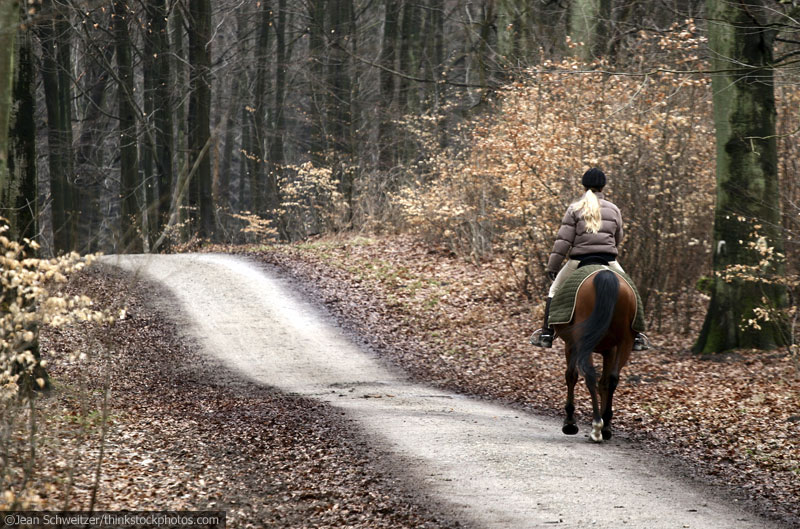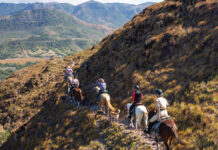Some of the most memorable rides are those enjoyed on a quiet, remote trail. Nothing could be finer. Without a worry in sight, your mind roams free as you absorb the beauty of the day and connect with your horse. And then, disaster strikes.

Emergency Plan
When you are faced with a crisis out on the trail, your prime objective is to execute a quick fix until you can get in touch with a vet. Before you head off on any ride, make sure someone knows what trail you’ll be on, and don’t deviate from this plan. Have a charged cell phone in hand, a GPS unit if possible, clothing for all kinds of weather and a well-stocked first-aid kit. Here are some common scenarios you might encounter on the trail.
Bleeding Laceration
Trails are full of obstacles that threaten to inflict cuts and scrapes as your horse fails to clear sharp branches or rocks while negotiating tough terrain or crossing creeks. If this happens, dismount and assess the damages when it is safe to do so.
If a blood vessel has been severed, you’ll know immediately—even a few tablespoons of blood looks like gallons. A horse can lose up to two gallons of blood before suffering life-threatening shock, but sufficient clotting of an artery may take 30 to 60 minutes, and most small vessels take at least 15 minutes.
Use the following steps to stop bleeding:
- Press your hand or fingers directly over the wound to stem blood flow.
- Cover the wound with a clean non-stick dressing, securing it firmly with self-adhesive bandaging.
- Apply ice (if available) over the wound and bandage to further constrict blood vessels.
- If your horse allows it, elevate his injured leg on a stump. Once blood stops oozing through the bandage, slowly make your way to veterinary assistance.
In a pinch, use the bottom four inches of your T-shirt to make a bandage compress to wrap around the wound. Apply duct tape to bind the compress to the leg, or you can knot strips of your T-shirt around the leg.
A common mistake with a hemorrhaging wound is to peek to see if the bleeding has stopped. Resist this temptation! Each time you disturb the clot, you’ll be starting the laborious process all over again. If you can’t get the bleeding to quit, a piece of saddle latigo or leather throatlatch can be crafted into a temporary tourniquet above the wound. Leave it on for no more than 15 minutes though; a tight tourniquet may injure tendons, and if left on too long, it can interfere with tissue circulation.
Punctures and Flap Wounds
Wounds that aren’t gushing blood, such as puncture wounds or those with a skin flap, should be bandaged.
- To keep the wound moist, apply antibiotic ointment and/or gauze compresses soaked in a saline solution (1/2-tablespoon salt per quart water).
- A dab of Super Glue will seal the top of a skin flap, but use it sparingly, as it is difficult to remove for later cleaning and treatment.
A more concerning injury is a punctured tendon sheath or joint. Cover the wound to prevent further contamination, and get veterinary help as soon as possible.
Rope Burn
While riding the trails is inspiring, there may be times when you want to tie or picket your horse and relax. This is when your horse might tangle a leg in the rope and panic.
- Cut the rope with a pocketknife (kept on hand for such emergencies) to hasten his release.
- Immediate care relies on quick cooling by immersing your horse’s leg in a cold creek or by applying ice.
- Silver sulfadiazine cream is especially useful for burn wounds and for any skin wound.
- Chapstick has been noted to provide relief if nothing else is available.
- Apply a light bandage (or T-shirt compress) to keep the wound clean.
Eye Injury
Horses run into things, sometimes head-first. An eye injury may be painful, but it’s usually not life-threatening.
- Non-steroidal antibiotic eye ointment provides lubrication to relieve pain, but only use medication formulated specifically for the eye; otherwise you will do more harm than good. Eye ointment can be used safely on other wounds, as well.
- If you think debris is trapped in your horse’s eye, splash it with water or gently flush it with a stream of water from a syringe to clear away foreign material. However, saline solution is the preferred eye rinse—either the commercial kind found on supermarket shelves or one made with a half-tablespoon of salt per quart of water.
- For a serious eye injury, fashion a bandage from a compress taped to the head. This protects the eye from sun, wind and debris, and keeps tissues moist until you can get to veterinary help.
Tendon Pull or Sprain
Uneven, rough trail terrain increases your horse’s risk of taking a misstep resulting in an acute tendon pull or joint sprain.
- The most effective emergency treatment, if available, is to stand your horse in a cold, running creek for 20 to 30 minutes to minimize the inflammation.
- A small oral dose of non-steroidal anti-inflammatory medication (phenylbutazone (Bute) or flunixin meglumine (Banamine) paste) helps diminish swelling and pain. Prior to your trail adventure, confer with your vet as to an appropriate dose when packing your first-aid kit.
- Periodic immersion in cold water is helpful as you slowly make your way off the trail.
Horseshoe Problems
Horseshoe-related problems are common dilemmas you may encounter on a trail. Your horse may spring a shoe, leaving it twisted yet still attached, which brings your ride to a halt since he can’t put his foot down flat. If you don’t carry shoeing tools in your cantle pack, a multipurpose tool proves invaluable for pulling a loose shoe.
- File nail clinches away, then pry the shoe off a little at a time with the closed pliers.
- Bang the shoe down against the hoof with a rock to expose the nail heads on the bottom of the shoe, which can then be plucked out individually to free the shoe.
- A horseshoe nail that has been broken off isn’t usually a problem, but remove it from the hoof when possible.
- Foot protection for a barefoot or injured hoof can be provided using a synthetic boot. If you don’t have one of these, then hand-walk your horse slowly down the trail on the softest footing available and return to the trailer.
Another common horseshoe problem is often heard first—the jingle of a loose shoe. Stop and attempt to fix it before the shoe falls off or gets sprung.
- Place your horse’s foot with a rock directly beneath the head of a loose nail; then use your multitool’s screwdriver or a small rock to pound a round rock directly over the nail clinch to re-tighten the shoe.
- Alternatively, you can place a hoof boot over the loose shoe to keep it secured.
A multitool is also handy for removing a broken stick that punctures the sole or skin, or to remove cactus spines or burrs from the legs.
The “Tied-Up” Horse
A tired, dehydrated, overheated or chilled horse may develop muscle cramps (myositis), particularly in the large muscles of the haunches or thighs. He may refuse to move—in a word, he is “tied up.” The first thing you might notice is an uneven or shortened stride, or a more obvious, hitching lameness. Some horses experience enough pain from the knotted muscle cramp to act colicky.
A horse with myositis is often able to be led down the trail, slowly.
- First let him rest quietly for 10 to 15 minutes by the side of the trail. He can graze and drink. Many horses “warm” out of a mild cramp as circulation restores to fatigued or overheated muscles.
- Administer a dose (2 ounces) of electrolytes, especially once your horse is drinking.
- If he won’t move at all and the weather is chilly, wet or windy, cover his haunches with a rump rug, the saddle blanket or your jacket.
Muscle cramps may be mild, but some cases can be life-threatening. Muscle damage releases myoglobin (large proteins) from the muscle tissue, which don’t filter well through the kidneys. Dark brown or wine-colored urine indicates myoglobin release from muscle; this can initiate a cascade of damage leading to kidney failure. Proper treatment is intravenous fluids administered by a veterinarian as quickly as possible to flush out the kidneys; seek a local vet clinic.
Lost Horse
Losing your horse in the backcountry is a serious emergency. Many years ago while on a two-month-long trail ride spent camping in the Rocky Mountain wilderness, I discovered a couple of tricks for finding lost horses. Hobbles did little to deter their nightly roaming. These general rules apply:
- They tend to go back up the most recently traveled trail.
- If that return route is not accessible, they tend to go uphill rather than down.
These tips give you a basic starting place from which to search. If you can’t find your horse, then beat a track out of the woods and find the nearest helicopter pilot to give you a bird’s eye tour.
Being prepared with a plan and equipment to handle most equine first-aid emergencies on the trail will give you peace of mind as you head off into the hills for that long, relaxing ride.
Liked this article? Here are others on trail safety:
Trail Riding Injuries
Trail Riding Problem Solver
This article originally appeared in the July 2010 issue of Horse Illustrated. Click here to subscribe.





